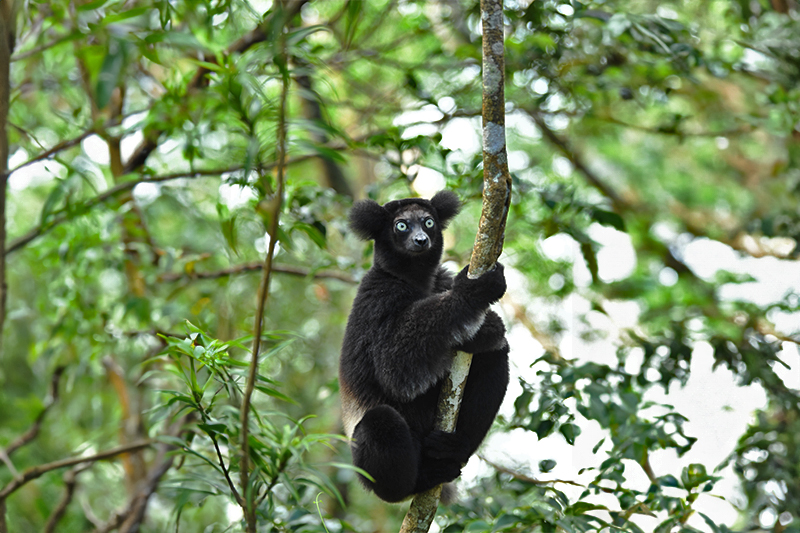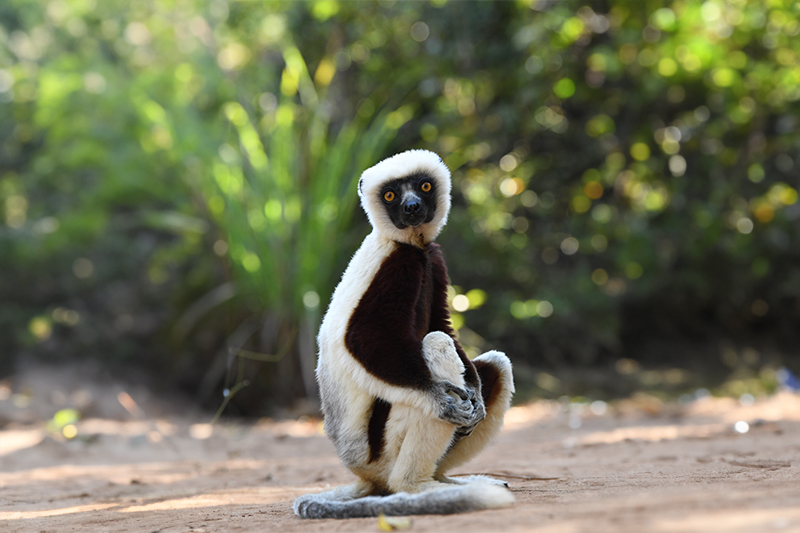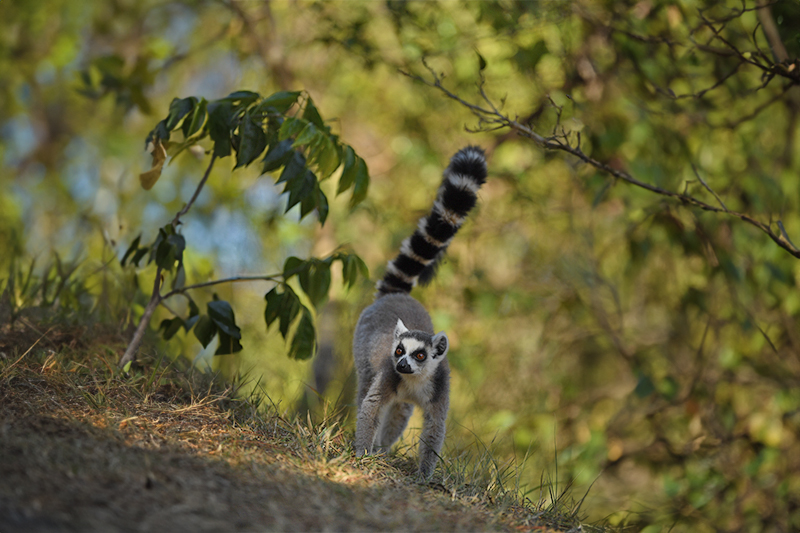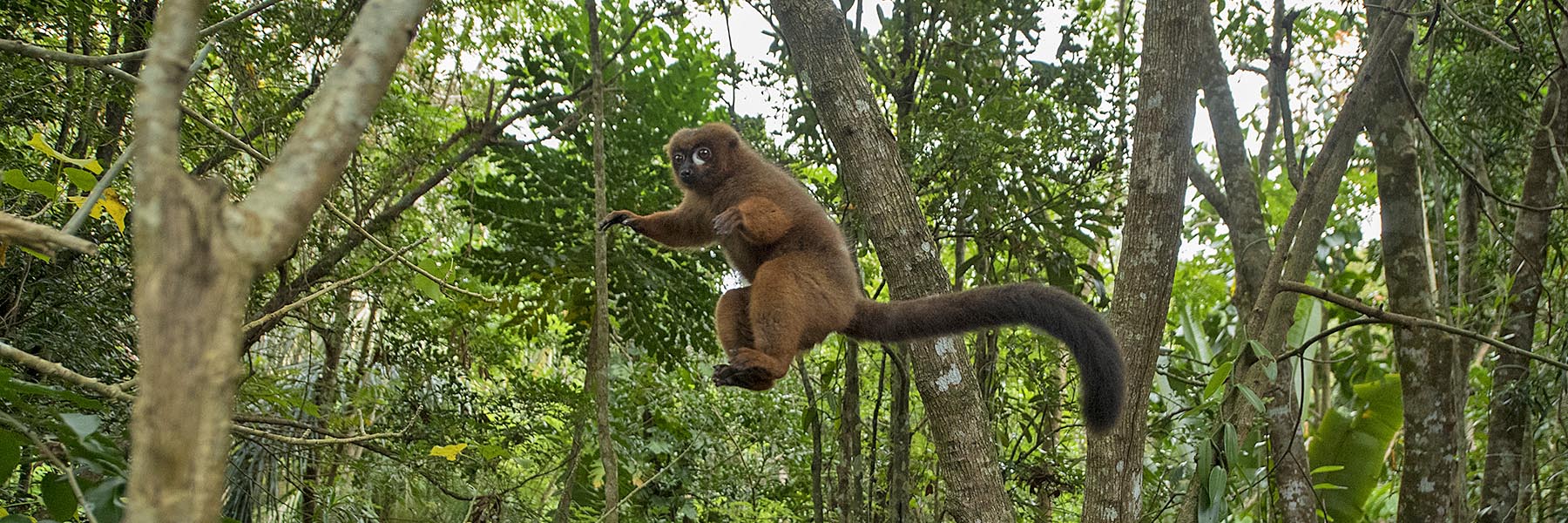Madagascar is unlike the popular African game-viewing destinations; no savannahs or places that are teeming with mammals here. Instead, there are dense forests, and spotting the wildlife here means trekking through these forests. Professional guides accompany you on a wildlife-viewing expedition, making it a fun and adventurous way to explore.
While there are no big cats or typical African wildlife in Madagascar, it is home to unique species like lemurs, chameleons, and snakes, most of which are endemic. This makes the wildlife of Madagascar truly one-of-a-kind, with species you can’t see anywhere else on the planet. Due to its extreme species endemism and richness, UNESCO has declared it a biodiversity hotspot. Let us share some of the top wildlife to spot in Madagascar.

Lemurs
Madagascar’s isolation from the rest of the world and a lack of predators has created a suitable habitat for various lemur species, numbering more than 30. This makes Madagascar the only place in the world where Lemurs can be found in the wild. You can spot Lemurs in Ankazoberavina Island, Beremy Reserve, and Ranomafana National Park. Following are some famous kinds of Lemurs seen in Madagascar.

Indris
The Indris bear a resemblance to humans and are known for their loud and distinctive calls, earning them their nickname, “whale of the forest”. They can grow up to about 4 feet when fully extending their legs. The best places to see them in Madagascar are the montane forests and Andasibe National Park.


Sifakas
Verreaux’s sifaka is one of the most notable subspecies of lemurs. They possess long hind legs, and it is quite a delight to see their sideways hop movements. Other sifaka species found in Madagascar are diademed sifaka and the white-and-brown-coated Coquerel’s sifaka. Madagascar’s southwestern region is the best place to spot these funny creatures.


Aye-aye
Looking like a cross between bats and squirrels, these misunderstood creatures are considered an omen among the Madagascar locals and are often killed if spotted. Being a nocturnal lemur, it’s hard to spot them, but night walks near Farankaraina Forestry Reserve may treat you to the sight of these elusive creatures. They are notable for their exceptionally long middle finger, which they use to scoop out insects from tree barks.


Ring-tailed lemurs
Ring-tailed lemurs spend most of their time on the ground and are sociable creatures. They are easily recognized, thanks to their long, black, and white ringed tails. These lemurs live in groups, as large as 30 lemurs, and often huddle together to keep warm. They often sunbathe- sitting upright facing their underside. Ring-tailed lemurs are often found in the south of the island. The Ifotka Community Forest is a good tracking place.

Mouse Lemurs
Mouse Lemurs look like rodents and have huge eyes. The pygmy mouse lemur is the smallest primate in the world, with its body less than two and a half inches long. They live in the dry forests of western Madagascar and rarely leave the trees. Mouse lemurs live in female-dominated groups of about 15 animals. These nocturnal animals scavenge for food during the night for insects, flowers, and fruits.

Fossa
These endangered animals are Madagascar’s largest predators. They are cat-like carnivores that can feed on anything from lizards to lemurs and even chickens. Their habitat is threatened due to hunting and deforestation; it’s difficult to get estimates of the dwindling numbers of these elusive animals. They are present in the Kirindy Reserve near Morondova in western Madagascar.

Chameleons
Nearly half of the world’s chameleon species find their home in Madagascar. Spotting chameleons, however, is quite difficult as they hide in trees and change their colour according to their surroundings. Their size ranges from 1.4-inch-long pygmy stump-tailed chameleons to 24-inch-long Parson’s chameleons. One can spot them near Nosy Be or Anja Community Reserve.


Birds
Couas
These large, terrestrial birds belonging to the cuckoo family are endemic to Madagascar. They feature brightly coloured bare skin around their eyes and large feet with a reversible third toe. There are nine species in all, three of them (blue, red-fronted, and red-breasted) inhabit eastern Madagascar, while the other six (giant, Coquerel’s, running, Verreaux’s, red-capped and crested) prefer the dry forests of south and west Madagascar.
Vangas
Vanga-shrike, or simply vangas are about 5 to 12 inches long and moderately long wings and tails. Most species are glossy blue or black above and white below. Some also have white heads and reddish-brown markings. These birds are spread all over the island; some subspecies prefer the dry deciduous forests of the west, others inhabit the rainforest in the east, and some live in the scrub habitats of the southwest.
Red Owls
These rare and enigmatic owls, endemic to Madagascar, are unlikely to be seen unless one is specifically searching for them. They’re quite similar to the Barn owl but have an overall ochre-reddish to yellow-ochre colour. Their call is loud and screeching, lasts for about 1.5 seconds, and drops in pitch towards the end. They prefer the humid forests of Madagascar, like Amber Mountain National Park.

Frogs
There are more than 300 species of Frogs in Madagascar, of which about 99% are endemic. The only species of amphibians found is frogs; Madagascar does not have toads, newts or salamanders. Some of the most popular frog species are the Mantella, Tomato Frogs, Boophis, etc.


Insects
Giraffe Weevils
These weevils are endemic to Madagascar and derive their name from their extended neck, much like a giraffe. The males are just under 2.5 inches long. The lengths of their necks are 2-3 times more than those of females, making the giraffe weevil sexually dimorphic. They are black with a red covering on the wings. These insects are found in the rainforests of Ranomafana National Park and sometimes are spotted in Andasibe
Flatid Leaf Bugs
These beautiful pink leaf-shaped bugs secrete a white substance that provides camouflage against predators. They are found in the western forests of Madagascar, but one can also come across them near Anja Community Reserve.
Comet Moths
These moths are native to the rainforests of Madagascar. The males have a wingspan of 20 cm and a tail span of 15 cm, making them the world’s largest silk moths. The yellow wings have brown marking and eye-like patterns. These moths have a short life span of just one week, and the adult moths cannot feed on plants to survive. So, their short life is a race against time to find a mate and reproduce.
Humpback Whales
During the moths of June to October, humpback whales migrate from Antarctica to breed and calve in Madgascar’s warm waters. The island of Nosy Baraha is a lovely place to spot them breaching the waves, or you can also head out on a boat trip from Ile-Sainte-Marie.

So, if you’re looking for something different from the African safari, the wildlife of Madagascar is truly special. With its unique species and dense forests, it’s a chance to explore nature in a way that’s both exciting and rewarding. Why not make Madagascar your next wildlife adventure? You won’t find these incredible creatures anywhere else in the world!
If you loved reading this story, then subscribe to our blog here (it will ask to verify your email) to get inspiring travel stories and trivia delivered to your email. Stories about wildlife trivia, cultural experiences, curated luxury hotel lists, underrated places to travel, polar journeys and much more.











